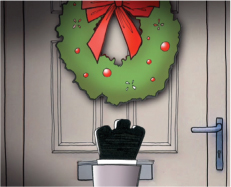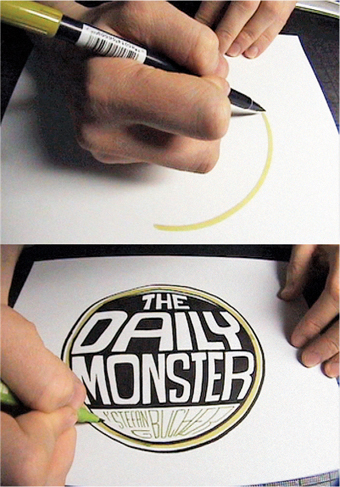DO THAT WHICH IS CLOSE TO YOUR HEART. IT’S AN EXPRESSION OF WHAT YOU LOVE IN LIFE, AND OTHERS WILL RECOGNIZE THAT.
There are so many ways to get inspired; to feed yourself. No one is looking through design annuals ripping people off because they’re lazy or mean. It just feels comfortable. Designers, like all humans, want to run with the tribe on some level. You stick with the family by copying the behavior and work of others. You align yourself. You calibrate. You get comfortable and efficient. By looking at annuals, you figure out what you need to do to get into annuals, but if you want to evolve your own work, looking at annuals is a dead end, of course.
I don’t really switch off inspiration anymore. I’ve broken down the barrier between me and what surrounds me. Everything is editable. I crop my environment, looking at everything as a Photoshop source and a retouching opportunity. I take photos when I can, but there are times when I force myself not to take notes or photos, so I have to truly remember. Otherwise, I start remembering the photos and wipe out the memory of the experience in the process.
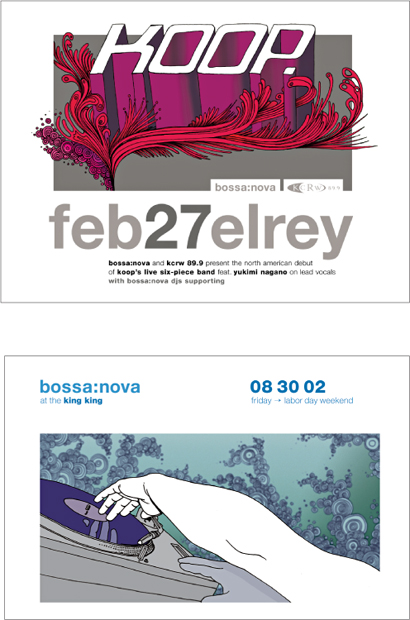
Back in 1999, I started designing and illustrating flyers for bossa:nova, Jason Bentley’s weekly club night here in Los Angeles. My friend Jennifer Stone was in charge of that, and handed me a flyer to one of the shows—Kruder & Dorfmeister. I said, “Could I please redo your fliers, just as kind of a humanitarian type gesture? They can’t stay like this.”
When it comes to pursuing new ideas in my work, I have a factory showroom model theory. No client wants to be the first to buy anything. They all want to be the second—after someone else already worked out the kinks. You have to have at least one produced example to show that it won’t blow up, that you know how to get it done.
Graphic design and illustration are all about taking control of a little piece of the world and making it look exactly as you would want it to be, and the fliers I created for bossa:nova were one of the first times I was really able to do that. I did dozens of them for about five years. Around the same time, I started making the flower posters for New Year’s. These were projects I created for myself as the client; they were my R&D department and my showroom models so that I could go to a potential paying client and say, “You like these? I’d like to do something like this for you.” Start doing what you want to do so that you can get the kind of work you want.
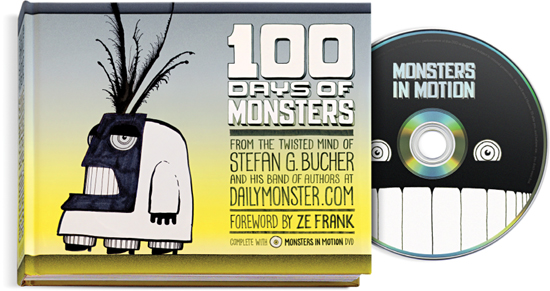
It’s like this for me; the responsible thing is to do that which is close to your heart. It’s an expression of what you love in life, and others will recognize that. They’ll say, “I understand how this feels for you. I do something different, but that’s how it feels for me, too.” And they just want to be a part of it.
01
I don’t plan what I’m going to do, I plan the method and then let the thing become what it wants to become. I have the tools to facilitate that process.

02
When I start, I don’t know what the drawing or the monster will look like or what the story will be. I discover it as I go along.
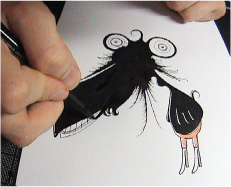
03
The story comes totally out of the shape each monster chooses to assume. The Christmas monster has this huge beak, which means that it probably has a loud, strange bird voice. Everything flows from that.
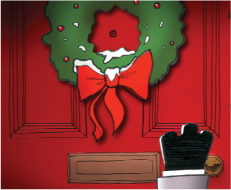
04
After the timelapse drawing is finished and the Holiday Monster walks off the paper and out of frame, we fade to black and enter a new scene. A monster hand knocks on a festively decorated door.
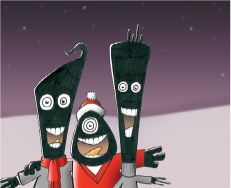
05
The door opens and reveals three caroling monsters. They launch into a spirited version of “Deck the Halls.” It’s clear that they’ve practiced hard. They’re very good singers with sweet voices.
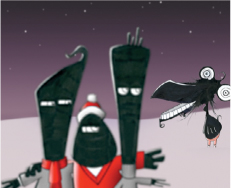
06
Suddenly, our Holiday Monster walks into the scene. It decides to join in the fun and begins to sing along—loudly and badly. It has the heart of Pavarotti and the voice of a wounded goose. The carol is ruined. The other monsters are not happy, as the door slams in their face.

07
They angrily tell the poor Holiday Monster to get lost . . .
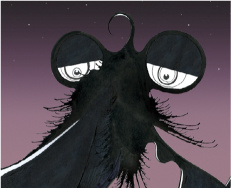
08
The Holiday Monster is sad. It meant no harm. It just wanted to sing along with the others. It hangs its head and moves back. It doesn’t want to cause trouble.
09
The other monsters go on to the next house. They knock and get ready to try again.
When the door opens they start into “Jingle Bells.” All is well and they’re sounding better than ever. The Holiday Monster looks on from a distance.

10
He simply can’t resist the music. It just has to join in. And it does. And it’s awful. Pee Wee Herman after a botched tracheotomy would sound better than this. Another door is slammed shut, and the caroling monsters are getting seriously ticked off. They decide to take action.

11
The Scarf Monster produces a long rope . . .
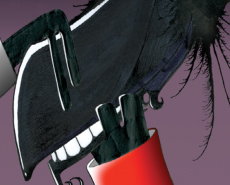
12
... as Red Sweater and Turtleneck make for the Holiday Monster. They grab his beak and get to work. As the screen fades to black, we hear the sounds of a struggle.
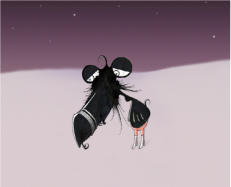
13
When the dust . . . well, when the snow settles, the Holiday Monster realizes what happened. The others have tied up its beak. It struggles to free itself, but its arms are too short. It gives up and starts crying—heaving with big honking sobs of disappointment and despair.
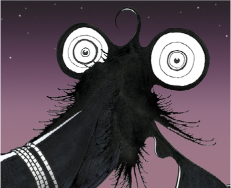
14
But just when things are at their bleakest, as it hears itself sob, inspiration strikes! We fade to black.

15
As the picture fades back up, the Holiday Monster’s beak knocks on another door. The door opens . . .
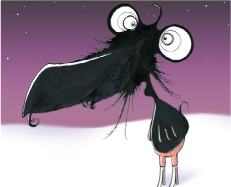
16
. . . and the Holiday Monster bursts into a brilliant, jazzy version of “Jingle Bells” using its expanding and retracting beak like a trombone. It always knew that it loved making music. It just hadn’t figured out the right way to make it yet. The monster grins proudly and takes a bow. The End.
The whole thing becomes easier when I do quirkier work. As soon as you commit to putting out work that’s personal to you, you start meeting people who do their own thing. It becomes a feedback loop. They start letting you in on interesting things that allow you to make more interesting things that inspire them. Once that kicks in, you’ll have so many opportunities to work that you can start being selective and be conscious of what you want your work to be.
I started out as an illustrator in Germany. I did everything by hand. Then I went to Art Center College of Design and got a computer. I could finally do the straight lines, smooth gradations, and crisp type I always tried to do by hand while growing up. After a few years of that, I realized I was hiding behind the method—the technique was a hedge. I got to the point where I said, “It’s time to put my own handwriting back into this.”
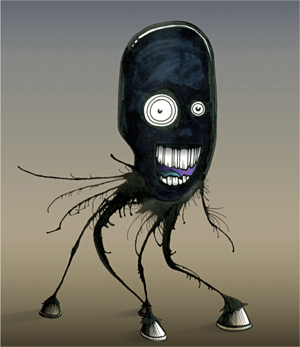
Daily Monsters came at a time when I really needed a creative outlet. The technique was surprisingly conscious—it came out of one of the New Year’s posters. The first poster out of that series was “344 Flowers.” At first, I used cocktail straws to blow the ink to create the technique, but I got a tremendous headache almost immediately, so I switched to pressurized canned air. The compressed air opened the door to those fantastic shapes. So, you see, I can depend on something other than my brain. The story came from the drawing. When you really have to start from scratch all your anxieties and fears come into it. But the blot gives me a start, and I can relax into my method.
It’s like music: You do years and years of scales so that you can start improvising. Design is improvisation. Modern design education wants to be cool, so it skips the scales and takes you straight to improvisation, because that’s the fun part! But it doesn’t work that way. The one thing that’s missing from almost every single portfolio I see is the ability to set type beautifully. You can’t get to the fun stuff without rigor. Skills come first. You have to know your craft at the body level.
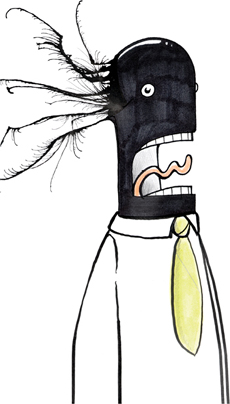
The first monster appeared on my arm as I was driving, and . . . well, it changed my life.


 344 DESIGN
344 DESIGN
